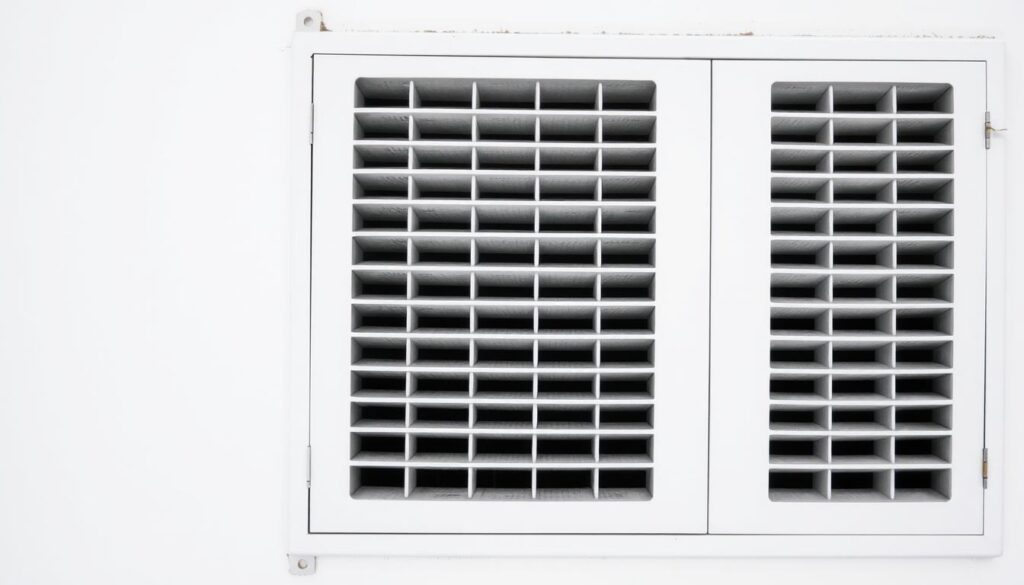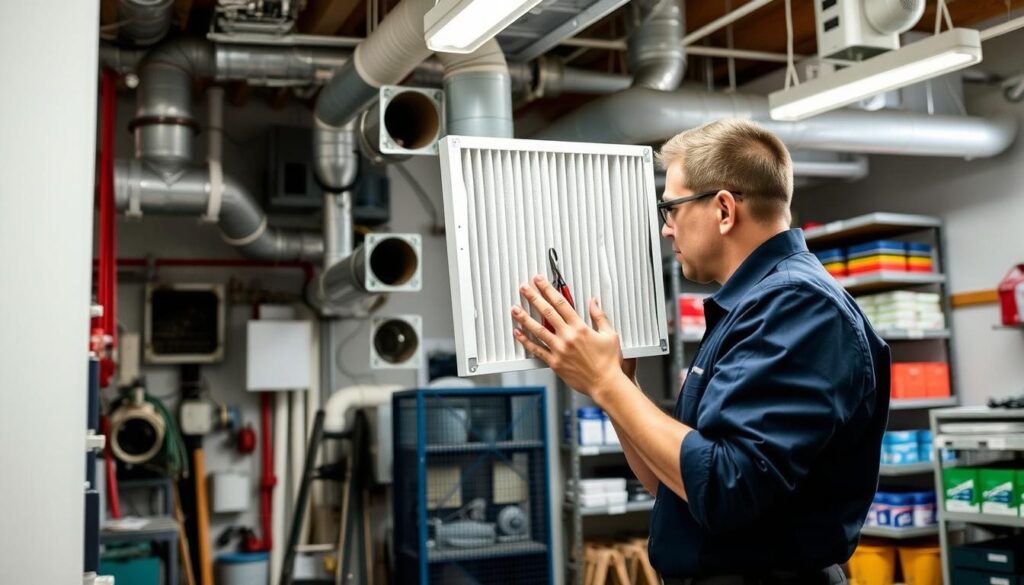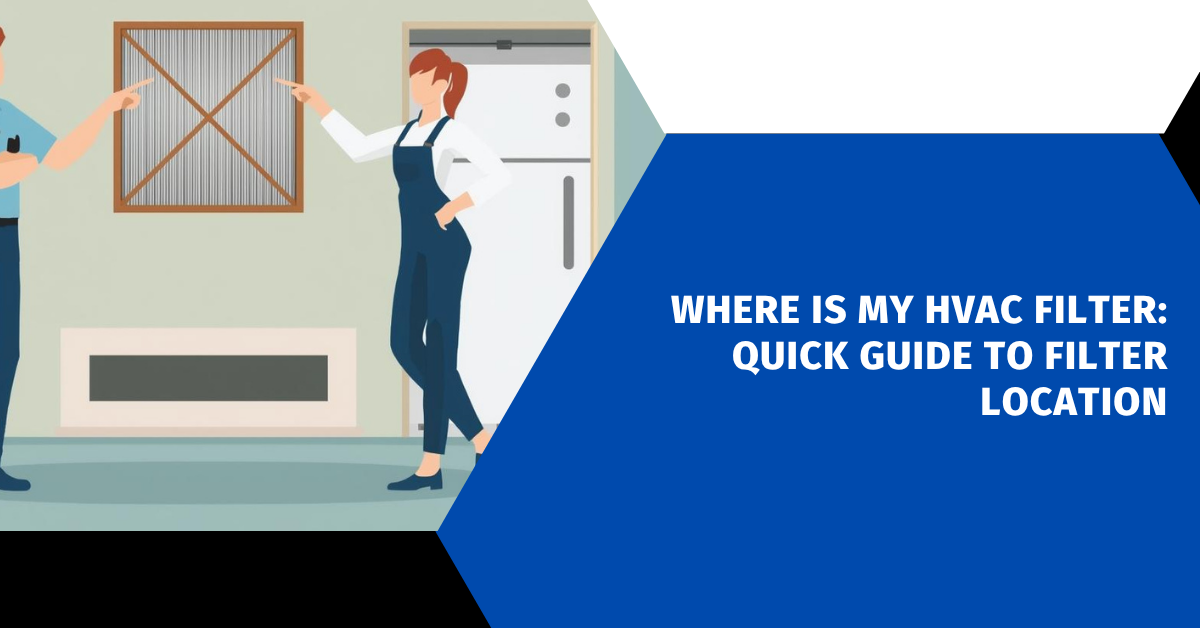Affiliate Disclosure
HVAC Guide Guys is a participant in the Amazon Services LLC Associates Program, an affiliate advertising program designed to provide a means for sites to earn advertising fees by advertising and linking to Amazon.
Where Is My HVAC Filter? Ever wondered where your HVAC filter is? Knowing where it is can save you time and money. It also helps avoid damage to your system.

The Environmental Protection Agency says to check your filter every month. They recommend replacing it every three months. Finding your hvac filter quickly makes these tasks easier.
HVAC filters are key to keeping your air clean and your system running well. They catch dust, allergens, and pollutants that move through your home’s heating and cooling system.
Key Takeaways
- Regular filter maintenance improves air quality
- Filter locations vary by HVAC system type
- Monthly inspections prevent system issues
- Proper maintenance extends your HVAC’s life
- Clean filters make your system more efficient
Table of Contents
Understanding HVAC Filter Basics and Their Importance
Your HVAC system’s filter is key to keeping your air clean and your system running well. Knowing how to maintain your air conditioner filter can save you money and make your home more comfortable.
Essential HVAC Filter Types
There are several types of filters, each with its own level of protection:
- Fiberglass Filters: Affordable but minimal filtration
- Pleated Filters: Better particle capture and air quality
- HEPA Filters: Maximum filtration for allergy sufferers
- Washable Filters: Reusable option for budget-conscious homeowners
Why Filter Maintenance Matters
Keeping your furnace filter clean is essential for your HVAC system’s health. A dirty filter makes your system work harder, raising energy costs and risking damage.
| Filter Status | System Efficiency | Energy Cost Impact |
|---|---|---|
| Clean Filter | Optimal Performance | Lower Energy Costs |
| Dirty Filter | Reduced Airflow | Higher Energy Expenses |
Indoor Air Quality Impact
Clean filters catch dust, pollen, and pet dander, making your air much cleaner. This is vital for people with allergies or breathing issues.
Replacing your air filter every 30-90 days can dramatically improve your indoor environment and HVAC system performance.
Common Locations for HVAC Air Filters
Looking for an AC filter in your home? Knowing where the central air filter is can save you a lot of time. HVAC filters are usually hidden in several important spots in your home’s cooling system.
- Return air vents or grilles
- Air handler cabinet
- Inside ductwork
- Basement utility areas
- Attic mechanical spaces
The most common place for a central air filter is near the return air duct. This spot helps catch dust and debris before it gets into the HVAC system. Look for a big metal grate on your wall, ceiling, or floor. This is probably your return air vent.
Pro tip: Some homes have filters in different places, depending on their HVAC system. Check near your furnace or air handler for more filter slots.
Having trouble finding your filter? Look in these specific spots:
- Behind the large metal grate near your thermostat
- Inside the air handler cabinet
- Near the basement or utility room’s HVAC equipment
Remember, every home’s HVAC system is different. So, if you can’t find the filter right away, don’t worry. If you’re unsure, check your system’s manual or call a local HVAC expert for help.
Explore Our HVAC Shop
Looking for top-rated HVAC tools, parts, and accessories? Visit our shop and find the perfect solution for your needs.
Visit the ShopWhere Is My HVAC Filter in Different System Types
Knowing where your HVAC filter is can save you time and make your system work better. Each type of HVAC system has its own filter spot. You need to know where it is to change it right.
To find the air filter in your heating system, you must know your HVAC unit’s setup. The filter’s spot can change a lot, based on the system and how it’s set up.
Horizontal HVAC Units
Horizontal units are often found in:
- Attics
- Large basements
- Garages
To find where to change the filter in horizontal units, look for a slot on the air return side. These systems usually have filters that slide in and out easily. This makes it simple to keep them clean.
Vertical HVAC Units
Vertical systems are common in:
- Small basements
- Crawl spaces
- Utility closets
For vertical units, filters slide into a slot above or below the main unit. You might need to remove a panel or cover to get to the filter area.
Special System Configurati ons
Some HVAC systems have special filter spots that need extra care. If this is the case, check your system’s manual or ask a professional HVAC technician. They can help you find the filter’s exact spot.
Pro tip: Always turn off your HVAC system before trying to find or change the filter. This keeps you safe.
Finding Filters in Return Air Ducts
Return air ducts are key to your home’s HVAC system. They pull air from your living spaces back to the unit. Knowing where your hvac filter is can keep your system running well.
Return air ducts are found in key spots around your home. These include:
- Walls near the floor or ceiling
- Utility closets
- Hallway ceilings
- Basement areas
To find your air filter, look for the large metal grilles. These are the return air vents. Not all return air ducts have filters directly behind the grate. You might need to dig deeper.
Here’s how to find your HVAC filter:
- Remove the return air duct cover carefully
- See if the filter is right behind the grate
- Look for a filter slot or compartment in the ductwork
- Measure the current filter size for a new one
Checking your return air ducts regularly keeps air clean and your HVAC system efficient. If you’re not sure how to access the filter, a pro HVAC technician can help.
Locating Filters in the Air Handler Cabinet
Knowing where your HVAC filter is can save you time and boost your system’s performance. The air handler is key to your home’s comfort, housing important parts for heating and cooling.
Learning how to maintain your HVAC is vital. The air handler is a big metal box linked to your ductwork. It’s often found in utility rooms, basements, or garages.
Accessing the Air Handler Safely
Before you start, follow these steps:
- Turn off your HVAC system completely
- Find the main electrical panel and switch off power to the unit
- Wait a few minutes for everything to stop moving
Identifying Filter Placement Inside the Cabinet
When you open the air handler, look for these spots:
- Between the return air duct and blower compartment
- Near the blower motor
- In a dedicated filter rack or slide-out compartment
Common Filter Installation Insights
Most home HVAC systems have filters that are 1-4 inches thick. Remember, the arrow on the filter shows the airflow direction. Make sure the new filter fits well, without gaps for unfiltered air.
Keeping your filter clean is key for your HVAC’s health and your home’s air. Check it every 30-90 days, based on your home’s needs and the maker’s advice.
Explore Our HVAC Shop
Looking for top-rated HVAC tools, parts, and accessories? Visit our shop and find the perfect solution for your needs.
Visit the ShopBehind Return Air Grilles: A Common Filter Location

Looking for an AC filter in your home? A common spot is behind return air grilles. These vents are on walls or ceilings and are key to your HVAC system.
Return air grilles are usually metal or plastic, shaped like rectangles or squares. They have slats and are placed around your home. Their job is to pull air back into the HVAC system for cooling or heating.
- Check walls near the floor or ceiling for return air grilles
- Look for large, rectangular metal covers with visible slats
- Return air grilles are often located in hallways or central areas
To change your HVAC filter, follow these steps:
- Find the return air grille
- Remove the cover by:
- Unscrewing mounting screws
- Pressing release clips
- Gently pulling the cover away from the wall
- Take out the old filter
- Check the filter’s size on its frame
- Put in a new filter that matches the size
- Securely replace the grille cover
“Checking your return air grilles regularly can help maintain optimal HVAC system performance and indoor air quality.” – HVAC Maintenance Experts
Pro tip: Always install the new filter with the airflow arrow pointing toward the return air duct to ensure proper filtration.
| Filter Location | Typical Features | Maintenance Frequency |
|---|---|---|
| Behind Return Air Grilles | Wall/Ceiling mounted vents | Every 1-3 months |
| Air Handler Cabinet | Near HVAC unit | Every 3-6 months |
Signs Your Filter Needs Immediate Replacement
It’s important to know when to replace your air conditioner filter. This keeps your home’s air clean and your HVAC system running well. If you ignore replacing your filter, you might face big problems. These can make your home less comfortable and less efficient.
Visual Indicators of Filter Wear
Your HVAC filter shows you how it’s doing through its looks. Look out for these signs that it’s time for a new filter:
- Gray or dark coloration covering the entire filter surface
- Visible dust accumulation and debris buildup
- Physical damage like tears or warping
- Filter appears clogged or compressed
Performance-Related Warning Signs
Changes in how your system works can mean it’s time for a new filter. Keep an eye out for these signs:
- Reduced airflow from vents
- Unexplained increase in energy bills
- Unusual whistling or rattling sounds from HVAC system
- Inconsistent room temperatures
System Efficiency Impacts
A dirty filter makes your HVAC system work too hard. This lowers its efficiency. Regular furnace filter replacement prevents long-term damage and keeps your system running well. Experts say to check filters monthly and replace them every 60-90 days, based on your home’s environment.
Pro tip: Set calendar reminders for consistent filter maintenance to prevent unexpected system breakdowns.
Explore Our HVAC Shop
Looking for top-rated HVAC tools, parts, and accessories? Visit our shop and find the perfect solution for your needs.
Visit the ShopProfessional Tips for Filter Maintenance

Keeping your central air filter in top shape needs careful planning and attention. HVAC experts suggest several important steps to keep your system running smoothly.
Choosing the right filter is key for the best performance. Here are some vital hvac maintenance tips:
- Check the manufacturer’s recommended filter size
- Understand MERV ratings for air quality
- Inspect filter direction arrows before installation
- Replace filters every 90 days for standard home environments
“A well-maintained HVAC system can reduce energy costs by up to 15%,” says energy efficiency expert Mark Rodriguez.
The position of your central air filter is very important. Improper installation can lead to decreased airflow and increased energy consumption. Always make sure the filter’s airflow arrow points toward the furnace or air handler.
Professional maintenance is more than just replacing filters. It’s also wise to schedule annual HVAC system inspections. This helps catch problems early and keeps your system running efficiently.
- Clean surrounding areas before filter replacement
- Wear gloves during filter handling
- Document filter change dates
- Keep maintenance records for future reference
By following these professional hvac maintenance tips, you’ll make your system last longer and improve the air inside your home.
Conclusion
Knowing where your HVAC filter is can save you time, money, and energy. By understanding where it might be, like in return air ducts or air handler cabinets, you’ll keep your system running well. This also helps keep the air in your home clean.
Checking your HVAC filter regularly is easy once you know where it is. Whether your system is horizontal, vertical, or has a special setup, finding and changing the filter isn’t hard. Just make it a regular part of your home care routine.
Your HVAC system works best when you take care of it. By knowing where your filter is and changing it when needed, you’ll make your system last longer. This also improves the air quality in your home and saves you from costly repairs. Don’t forget to make filter checks a regular part of your home care.
Every HVAC system is different, so get to know where your filter goes. If you’re not sure, a professional HVAC technician can help. They’ll give you advice that fits your home’s specific system and filter needs.

